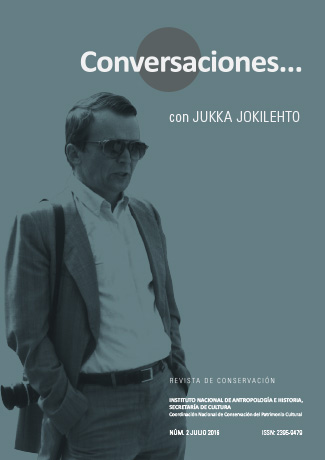Artículos
Valores patrimoniales, la perspectiva del actor social: la historia de Manuel y su barrio patrimonial
Published 2017-05-26
Keywords
- valuation,
- urban heritage,
- social representations,
- social actor,
- conflict
How to Cite
Valores patrimoniales, la perspectiva del actor social: la historia de Manuel y su barrio patrimonial. (2017). Conversaciones con. , 2, 89-100. https://revistas.inah.gob.mx/index.php/conversaciones/article/view/10890
Abstract
Using a fictional story involving Manuel –a neighbourhood leader- and Claudio –a historian architect- who are joining their efforts in trying to stop the destruction of a historic port neighbourhood through declaring its legal protection, this paper aims at exemplifying numerous real case scenarios in which we are faced with difficulties and limitations for the enhancement of heritage sites centred in common or “universal” values, using Jokilehto’s words from “Heritage values and valuation” (2016). Two additional characters are added to the story, allowing the setting of four different points of view, interests and valuation forms, which are sometimes openly opposed, while at other times they are complementary; but they all tend to differ in the means and courses of action used to achieve a same end. As a consequence, the valuation of a historic setting will converge, sometimes as nostalgic views of the past, sometimes as inspiration for the future; at other times, they are simply indifferent views, with a pragmatic approach to the present. Combined together, they form a scenario in which conflict is always around the corner. By uncovering the real difficulty of applying the concept of Outstanding Universal Value, I consider the need of delving into the theoretical developments, and well as into the tools and methodologies that will allow us a better management of heritage in the Latin American context. These should allow for a more in-depth understanding and a more adequate treatment of the different voices of a territory (in agreement and disagreement), which would lead us to achieve the expected results, and which can also be socially sustainable over time.Downloads
Download data is not yet available.
References
- Appadurai, Arjun (2001) [1996] La modernidad desbordada, Trad. G. Remedy, Ediciones Trilce, Montevideo.
- Bervejillo, Federico (s/f) Territorios en la globalización. Cambio global y estrategias de desarrollo territorial. Instituto Latinoamericano y del Caribe de Planificación Económica y Social, Documento 96/34 Serie Ensayos, [http://www.upo.es/ghf/giest/ODTA/documentos/MarcoTeorico/ILPES/bervejillo_desterglob.pdf], (consultado el 10 de noviembre de 2015).
- Bozzano, Horacio (2000) Territorios pensados, territorios reales, territorios posibles: aportes para una teoría territorial del
- ambiente, Espacio Editorial, Buenos Aires.
- Buckingham-Hatfield, Susan and Susan Percy (eds.) (1999) Constructing local environmental agendas, Routledge, London.
- Bürgi, Matthias, Anna M. Hersperger and Nina Schneeberger (2004) “Driving forces of landscape change - current and new
- directions”, Landscape Ecology, Volume 19, Number 8, pp. 857-868.
- Elizaga, Julieta y Bernardita Ladrón de Guevara (2009) “La conservación-restauración en un escenario plural de valoraciones:
- caminos para una aproximación conceptual”, Conserva, Número 13, pp. 81-94.
- García-Canclini, Néstor (2005) [1990] Culturas híbridas: estrategias para entrar y salir de la modernidad, Paidós Estado y
- Sociedad, Buenos Aires.
- García-Canclini, Néstor (1999) “Los usos sociales del patrimonio cultural”, en: Encarna Aguilar Criado (ed.), Patrimonio etnológico. Nuevas perspectivas de estudio, Consejería de Cultura, Junta de Andalucía, Instituto Andaluz del Patrimonio Histórico y Editorial Comares, Sevilla, pp. 16-33.
- Ladrón de Guevara, Bernardita y Julieta Elizaga (2009) “Diagnóstico para la conservación de patrimonios culturales en uso activo: propuesta metodológica”, Conserva, Número 13, pp. 61-80.
- Ladrón de Guevara, Bernardita, Darío Toro, Rafael Prieto y Carolina Chávez (2015) “Patrimonio, territorio y paisaje: huellas del
- aprendizaje a ocho años de la creación de la Unidad de Geoinformación del Patrimonio”, Conserva, Número 20, pp. 123-130.
- Luginbühl, Yves (2008) “Las representaciones sociales del paisaje y sus evoluciones”, en: Javier Maderuelo (dir.), Paisaje y territorio, Abada Editores, Madrid, pp. 143-180.
- Martínez Yáñez, Celia (2010) “La redefinición del valor universal excepcional y el futuro de la Lista del Patrimonio Mundial”, e-rph, junio 2010, Número 6, pp. 1-11.
- Mongin, Olivier (2006) [2005] La condición urbana: la ciudad a la hora de la mundialización, Trad. Alcira Bixio, Editorial Paidós, Buenos Aires.
- Mora, Martín (2002) “La teoría de las representaciones sociales de Serge Moscovici”, Athenea Digital, Número 2, otoño 2002.
- [http://www.raco.cat/index.php/Athenea/article/viewFile/34106/33945], (consultado el 26 de junio de 2016).
- Moscovici, Serge (1979) [1961] El psicoanálisis, su imagen y su público, Trad. Nilda María Finetti, Editorial Huemul, Buenos Aires.
- Verdier, Philippe (2009) Le projet urbain participatif: apprendre à faire avec ses habitants, Editions Ives Michel, Paris.

